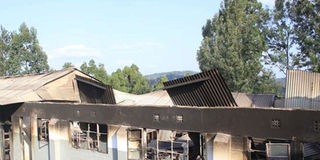This is why our children set schools ablaze

Kuja dormitory, one of seven burnt by students at Itierio Boys High School on June 25, 2016. PHOTO | BENSON MOMANYI | NATION MEDIA GROUP
What you need to know:
- Recent burnings have been as a result of implementation of school bedtime rules that have curtailed the students’ quest to watch late-night football matches.
- As is usual in this country, we are now asking why students are using arson as a method of expressing their dissatisfaction or anger.
- They are often confused about what is happening to them and will be constantly seeking answers from those around them.
- Children and adolescents will learn more by observation than by listening to lectures.
There has been another round of school-based violence, this time targeting dormitories and other school buildings.
A number of boarding schools have had to close after students burnt down their own dorms due to a perceived violation of their rights.
Recent burnings have been as a result of implementation of school bedtime rules that have curtailed the students’ quest to watch late-night football matches.
The latest incident happened right after Education, Science and Technology Cabinet Secretary Fred Matiang'i had left the school after giving a hard-hitting statement indicating that students would not be allowed to transfer from schools where such incidents shall have occurred.
He also said that the government would not be spending money to rebuild schools burnt down by students, and parents would instead have to foot the bill.
And immediately he boarded a plane heading back to the city the students allegedly went on the rampage and burned down some school buildings.
As is usual in this country, we are now asking why students are using arson as a method of expressing their dissatisfaction or anger, and indignantly looking around for someone to blame or hold responsible for this antisocial and unacceptable behaviour.
So today we shall once again explore this phenomenon for the umpteenth time.
UNDERSTANDING TEENS
We must first acknowledge that teens anywhere in the world are a mess of raging hormones and rapid bodily changes.
They are often confused about what is happening to them and will be constantly seeking answers from those around them.
That is the age in which they begin to learn how to interact with others in socially appropriate ways, how far they can go in exploration, and so on.
One of the things they imbibe from adults on a continuous basis is how to solve problems around them.
They do not learn this by listening to parents or teachers or other adults explaining how it is important to remain calm and composed in the face of adversity and to always think before you leap.
On the contrary, those exhortations often go into one ear and out the other.
THEY LEARN BY OBSERVATION
Children and adolescents will learn more by observation than by listening to lectures.
So, to understand what they have learnt from us, let us consider what we collectively do when angry, frustrated, or even just exasperated.
The first thing we do is to collect sticks and stones and run out to block roads, chanting violent slogans about the object of our hate.
Our favourite slogan is “bado mapambano” (the struggle continues), and we deploy during any confrontation with an adversary.
The second thing we do, once the confrontation really gets going, is to find a good number of used tyres and set them alight on the tarmac.
We will then dance around the flames like some creatures from the past, chanting incantations and curses against our hate object.
Occasionally we get more excited and turn on motorists trying to use the road.
We may stone their cars or even elect to burn them when the spirit moves us.
And when the anti-riot police get onto the scene, things often get even more interesting.
Teargas canisters will be hurled all over the place, all sorts of missiles will fly, and when the tear gas and rubber bullets run out, live bullets will be used.
VIGOROUS EXPRESSIONS
The question is, where are our children as we engage in these “vigorous expressions of our opinions”, to turn a phrase?
Do we blindfold them and hide them in “safe” places until the confrontation is done?
Of course not!
Some of us will go with our children to those confrontations, and when it is time to loot, we will encourage them to carry as much as they can.
We will give the bigger ones weapons and feed them with the language of violence, encouraging them to use it as long as it is directed at the hated “other”.
How then do we expect them to erase these exhilarating lessons learnt from their own parents when they go back to school?
After all, they are their parents’ children first!
So, there, now you know.
Lukoye Atwoli is associate professor of psychiatry and dean, School of Medicine, Moi University; [email protected].





